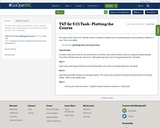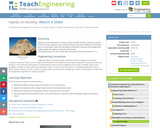
This task is from Tools 4 NC Teachers. Given a situation students use a coordinate grid to solve problems related to a race. This is remixable.
- Subject:
- Mathematics
- Material Type:
- Activity/Lab
- Formative Assessment
- Date Added:
- 07/10/2019

This task is from Tools 4 NC Teachers. Given a situation students use a coordinate grid to solve problems related to a race. This is remixable.

This task is from Tools 4 NC Teachers. Given a situation, students identify a pattern and continue the pattern. They also graph the pattern on the coordinate grid. This is remixable.

This task is from Tools 4 NC Teachers. Students plot points and solve problems related to points on a coordinate plane. This is remixable.

Students see how different levels of surface tension affect water's ability to move. Teams "race" water droplets down tracks made of different materials, making measurements, collecting data, making calculations, graphing results and comparing to their predictions and the properties of each surface, determining which surface exhibits the highest (or lowest) level of surface tension with water. They apply their results to make engineering recommendations for real-world applications.

This activity reinforces students' understanding of various math standards.

Students strengthen their communicate skills about measurements by learning the meaning of base units and derived units, including speed one of the most common derived units (distance/time). Working in groups, students measure the time for LEGO MINDSTORMS(TM) NXT robots to move a certain distance. The robots are started and stopped via touch sensors and programmed to display the distance traveled. Using their collected data, students complete a worksheet to calculate the robots' (mean/average) speeds at given motor powers.

Students learn about ultrasound and how it can be used to determine the shapes and contours of unseen objects. Using a one-dimensional ultrasound imaging device (either prepared by the teacher or put together by the students) that incorporates a LEGO(TM) MINDSTORMS(TM) NXT intelligent brick and ultrasonic sensor, they measure and plot the shape of an unknown object covered by a box. Looking at the plotted data, they make inferences about the shape of the object and guess what it is. Students also learn how engineers use high-frequency waves in the design of medical imaging devices, the analysis of materials and oceanographic exploration. Pre/post quizzes, a worksheet and a LEGO rbt program are provided.

Students learn about Pascal's law, an important concept behind the engineering of dam and lock systems, such as the one that Thirsty County wants Splash Engineering to design for the Birdseye River (an ongoing hypothetical engineering scenario). Students observe the behavior of water in plastic water bottles spilling through holes punctured at different heights, seeing the distance water spurts from the holes, learning how water at a given depth exerts equal pressure in all directions, and how water at increasing depths is under increasing pressure.

In this activity, students participate in a series of timed relay races using their skeletal muscles. The compare the movement of skeletal muscle and relate how engineers help astronauts exercise skeletal muscles in space.

Students use inclined planes as they recreate the difficult task of raising a monolith of rock to build a pyramid. They compare the push and pull of different-sized blocks up an inclined plane, determine the angle of inclination, and learn the changes that happen when the angle is increased or decreased.

Students develop awareness and understanding of the daily air quality using the Air Quality Index (AQI) listed in the newspaper. They explore what engineers can do to help reduce poor air quality.

Three short, hands-on, in-class demos expand students' understand of energy. First, using peanuts and heat, students see how the human body burns food to make energy. Then, students create paper snake mobiles to explore how heat energy can cause motion. Finally, students determine the effect that heat energy from the sun (or a lamp) has on temperature by placing pans of water in different locations.

Students learn about physical models of groundwater and how environmental engineers determine possible sites for drinking water wells. During the activity, students create their own groundwater well models using coffee cans and wire screening. They add red food coloring to their models to see how pollutants can migrate through the groundwater into a drinking water resource.

In this lesson, students will use graph coordinate points in order to graph a picture of a fish.